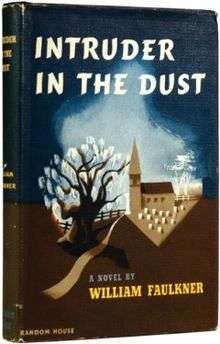Intruder in the Dust

Intruder in the Dust is a novel by the Nobel Prize–winning American author William Faulkner published in 1948.
Overview
The novel focuses on Lucas Beauchamp, a black farmer accused of murdering a white man. He is exonerated through the efforts of black and white teenagers and a spinster from a long-established Southern family. It was written as Faulkner's response as a Southern writer to the racial problems facing the South. In his Selected Letters, Faulkner wrote: "the premise being that the white people in the south, before the North or the Govt. or anybody else owe and must pay a responsibility to the negro."
Intruder in the Dust is notable for its use of stream of consciousness style of narration. The novel also includes lengthy passages on the Southern memory of the Civil War, one of which Shelby Foote quoted in Ken Burns' documentary The Civil War.
The characters of Lucas Beauchamp and his wife, Molly, first appeared in Faulkner's collection of short fiction, Go Down, Moses. A story by Faulkner, "Lucas Beauchamp", was published in 1999.
Faulkner was awarded the 1949 Nobel Prize for Literature for "his powerful and artistically unique contribution to the modern American novel."[1] The Nobel Prize was not specifically for his novel Intruder in the Dust but for the enduring contribution of his writing as a whole.
Intruder in the Dust was turned into a film of the same name directed by Clarence Brown in 1949 after MGM paid film rights of $50,000 to Faulkner. The film was shot in Faulkner's home town of Oxford, Mississippi.
Analysis
In her contemporary review of the novel, Eudora Welty noted its humor.[2] In a 1949 contemporary analysis of Faulkner's work, Dayton Kohler noted the particular feature of Intruder in the Dust of its dramatization of the hope of regeneration of the American Southern conscience, with respect to the position of black Americans in Southern American society.[3] John E. Bassett has commented that this novel represents a "serious attempt to explore contemporary Southern racism through Gavin and Chick".[4] Jean E. Graham has discussed the contrasting rhetorical styles of Gavin and Chick throughout the course of the novel.[5] Ticien Marie Sassoubre has examined the novel in the context of the social issues related to lynching in the American South, and then-recent American federal law with respect to black Americans.[6]
D. Hutchinson has elucidated the unifying literary devices of the novel.[7] Peter J. Rabinowitz has specifically looked at Faulkner's treatment of the form of the detective story, in the context of the genre of the "discovery novel", in Intruder in the Dust.[8]
References
- ↑ "The Nobel Prize in Literature 1949". Nobelprize.org. Retrieved July 3, 2013.
- ↑ Welty, Eudora (Winter 1949). "Review: In Yoknapatawpha". The Hudson Review. 1 (4): 33–47. Retrieved 2016-11-01.
- ↑ Kohler, Dayton (December 1949). "William Faulkner and the Social Conscience". The English Journal. 38 (10): 545–553. Retrieved 2016-11-01.
- ↑ Bassett, John E. (Fall 1986). "Gradual Progress and Intruder in the Dust". College Literature. 13 (3): 207–216. Retrieved 2016-11-01.
- ↑ Graham, Jean E. (Spring 1990). "Gavin Stevens in Faulkner's Intruder in the Dust: Only Too Rhetorical Rhetoric?". The Southern Literary Journal. 22 (2): 78–89. Retrieved 2016-11-01.
- ↑ Sassoubre, Ticien Marie (Spring 2007). "Avoiding Adjudication in William Faulkner's Go Down, Moses and Intruder in the Dust". Criticism. 49 (2): 183–214. Retrieved 2016-11-01.
- ↑ Hutchinson, D. (October 1972). "The Style of Faulkner's INTRUDER IN THE DUST". Theoria: A Journal of Social and Political Theory. 39: 33–47. Retrieved 2016-11-01.
- ↑ Rabinowitz, Peter J. (May 1979). "The Click of the Spring: The Detective Story as Parallel Structure in Dostoyevsky and Faulkner". Modern Philology. 76 (4): 355–369. Retrieved 2016-11-01.
External links
- Intruder in the Dust at the Internet Movie Database
- John Anderson page on William Faulkner
- Laurel Longe's article Lucas Beauchamp, Joe Christmas, and the Color of Humanity
| Preceded by Go Down, Moses |
Novels set in Yoknapatawpha County | Succeeded by The Town |